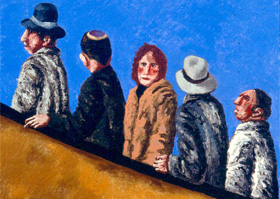NATALYA NESTEROVA: RUSSIAN WANDERINGS
The Washington Post, January 3, 2001
The Washington Post, January 3, 2001
| Natalya Nesterova Depicts Russia's New Freedom |
Most likely, Nesterova's refusal to politicize her work has been more aesthetic than ideological. Her canvases bear little resemblance to either the heroic realism of the "official" artists or the conceptualism of the dissidents. Instead, her work looks back to an earlier generation of painters. In its surrealistic lyricism, it recalls Marc Chagall; in its boldly and inventively applied brush strokes, it suggests expressionists like Chaim Soutine; and in its primitivist technique, it evokes Henri
Rousseau. The paintings are also strongly reminiscent of work by female Russian modernists like Lyubov Popova and Natalia Goncharova, whose work was recently gathered in a traveling exhibition titled "Amazons of the AvantGarde." In a strange bit of coincidence, the show's opening at Guggenheim Museum in New York coincided with the opening of
Nesterova's exhibition in Washington.
In looking at Nesterova's paintings for the first time, one is struck by the relative absence of faces. Often they are averted from the viewer or obscured by a startled pigeon, a moving hand or a similarly fleeting gesture. Some times they are concealed by a mask. The faces we do see are suspiciously similar, as though the figures that populate the canvases are stand-ins for experiences and ideas rather than fully formed individuals. This erasure of personality, and the attendant sense of lost time and alienation, is at the heart of Nesterova's subtle but effective way of communicating the frequently harrowing experience of Soviet life. "Natalya's paintings are a world unto themselves," says Alexandre Gertsman, the exhibition's guest curator. "But the personal and the political can never be completely separated." The exhibition closes on Jan. 15. The museum's address is 1640 Rhode Island Ave. NW, at 17th Street. It is open Sunday through Thursday from 10 a.m. to 5 p.m. and on Fridays from 10 a.m. to 3:30 p.m. For more information call 202-875-6583. |
|||
|
By Alex Halberstadt Special to The Washington Post There is an unexpected exhibition at the B'nai B'rith Klutznick National Jewish Museum. Among photographs of Jewish sports figures and a large collection of religious ceremonial objects, "Natalya Nesterova: Russian Wanderings" offers a series of recent paintings by one of Russia's most acclaimed artists. What's unusual is that Nesterova is not Jewish. Nesterova first began to depict Jewish imagery in the mid-'80s; at a subsequent exhibition, a painting of a boy, holding a Star of David drew unwelcome attention from the Soviet Ministry of Culture. For Rebecca Sobel, exhibitions coordinator at the Klutznick, one of the goals of the exhibition was to demonstrate Russian artists' relatively recent freedom to depict Jewish imagery, forbidden for decades during Soviet rule. "It's pretty revolutionary," says Sobel. "We want to show that this transition has taken place."  Nesterova includes a man in a yarmulke in "Stair" (1999), one of many Jewish images in her work
Nesterova includes a man in a yarmulke in "Stair" (1999), one of many Jewish images in her workOne suspects that for Nesterova, however, the Jewish figures in her paintings symbolize the outsider, a role occupied by Jews in Russia for centuries. In "Stair," a solitary figure wearing a yarmulke looks away while riding an escalator reminiscent of those leading to Moscow's crowded Metro. "In a Watchmaker's Shop" shows a lone Jewish figure adjusting the handsof a clock. His back is turned to the viewer. BenefitBenefit |
These paintings remind us that the artist can be an equally isolated figure, regardless of politics, ethnicity or religion. To be sure, only a fraction of the Mysterious canvases depict traditionally attired Orthodox Jews or the familiar symbols of Judaism.
Most of the paintings show landscapes populated by secular figures engaged in fairly mundane activities-meandering on a beach, lounging in a hammock, dining in a cafe.
At first glance, these lyrical, painterly works, with thick whorls of oil deposited on the canvas, can appear merely decorative or even coy, strangely reluctant to give away their meaning. However, a closer look reveals inflections ranging from the personal to the political, growing out of a lifetime that spans decades of Soviet repression as well as the turbulent events of Russia after the fall of communism. In 1998, Nesterova received the State Prize of Russia in Fine Arts, the highest honor bestowed on an artist; it was the culmination of a series of awards and museum retrospectives of her work. But her success was a new development in a career that for decades hung in a balance between state-sponsored propagandistic art and the freedom of expression sought by the country's underground artists. It was a struggle that defined Soviet art for decades and reached a turning point in the 1960s, when Nesterova began to exhibit her work. The mainstream was represented by the socialist-realist artists officially recognized and sanctioned by the state; their depictions of steelworkers and buxom farm women fell within the ideological and stylistic strictures espoused by Soviet censors. Artists unwilling to accede to these limitations worked in relative secrecy and under constant threat, frequently commenting on the banality and the repression of Soviet art and life. Vitaly Komar's and Alex Melamid's satirical sendups of Soviet propaganda and IIya Kabakov's recreation of cluttered communal apartments remain stinging indictments of the society in which they were created, and many dissident artists have since immigrated to the United States. |
|||



